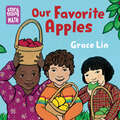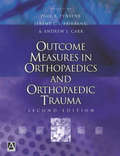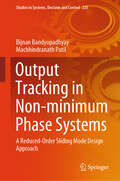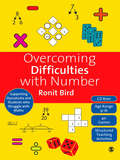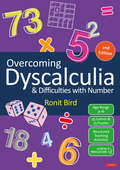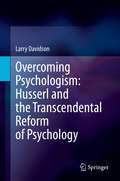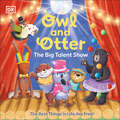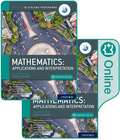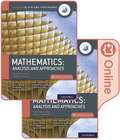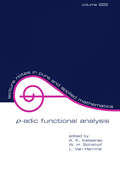- Table View
- List View
Our Days Are Numbered
by Jason BrownA revealing and entertaining look at the world, as viewed through mathematical eyeglasses.From the moment our feet touch the floor in the morning until our head hits the pillow, numbers are everywhere. And yet most of us go through each day unaware of the mathematics that shapes our lives.In fact, many people go through life fearing and avoiding mathematics, making choices that keep it at arm's length or further. Even basic math -- like arithmetic -- can seem baffling.In Our Days Are Numbered, Jason Brown leads the reader through a typical day, on a fascinating journey. He shows us the world through a mathematician's eyes and reveals the huge role that mathematics plays in our lives. It lies hidden within the electronics we use, the banking we do, and even the leisure activities we enjoy. Whether we're putting a down payment on a new car, reading the financial pages, or listening to our favourite songs, math is behind it all.At once entertaining and informative, Our Days Are Numbered covers an array of mathematic concepts and explores the hidden links between mathematics and everyday life. Brown reveals that a basic understanding of math can make us more creative in the way we approach the world.From the Hardcover edition.
Our Favorite Apples: Our Favorite Apples (Storytelling Math)
by Grace LinCaldecott Honor winner Grace Lin celebrates math for every kid, everywhere!Manny, Olivia, and Mei go apple picking and sort their red, green, and yellow apples by color. But then they find an apple that&’s all three colors. What should they do? A playful exploration of sorting, classifying, and friendship.Storytelling Math celebrates children using math in their daily adventures as they play, build, and discover the world around them. Joyful stories and hands-on activities make it easy for kids and their grown-ups to explore everyday math together. Developed in collaboration with math experts at STEM education nonprofit TERC, under a grant from the Heising-Simons Foundation.
Our Mathematical Universe
by Max TegmarkMax Tegmark leads us on an astonishing journey through past, present and future, and through the physics, astronomy and mathematics that are the foundation of his work, most particularly his hypothesis that our physical reality is a mathematical structure and his theory of the ultimate multiverse. In a dazzling combination of both popular and groundbreaking science, he not only helps us grasp his often mind-boggling theories, but he also shares with us some of the often surprising triumphs and disappointments that have shaped his life as a scientist. Fascinating from first to last--this is a book that has already prompted the attention and admiration of some of the most prominent scientists and mathematicians.
Our Mathematical Universe
by Max TegmarkMax Tegmark leads us on an astonishing journey through past, present and future, and through the physics, astronomy and mathematics that are the foundation of his work, most particularly his hypothesis that our physical reality is a mathematical structure and his theory of the ultimate multiverse. In a dazzling combination of both popular and groundbreaking science, he not only helps us grasp his often mind-boggling theories, but he also shares with us some of the often surprising triumphs and disappointments that have shaped his life as a scientist. Fascinating from first to last--this is a book that has already prompted the attention and admiration of some of the most prominent scientists and mathematicians.
Outcome Measures in Orthopaedics and Orthopaedic Trauma, 2Ed
by Jeremy Fairbank Paul Pynsent Andrew CarrOrthopaedics and orthopaedic trauma are highly complex subjects that can prove difficult to quantify, but accurate measurement is required for setting standards of care and for assessing the severity of an injury. This book will help the reader assess outcome instruments, and provides many references to sources of instruments and techniques to use.
Output Tracking in Non-minimum Phase Systems: A Reduced Order Sliding Mode Design Approach (Studies in Systems, Decision and Control #225)
by Bijnan Bandyopadhyay Machhindranath PatilThis book focuses on the systematic design of reduced-order sliding mode output tracking control for non-minimum phase systems. It presents a systematic method for the design of reduced order control law for a wide variety of systems. The target audience primarily comprises research experts in control theory, but the book may also be beneficial for graduate students.
Outstanding User Interfaces with Shiny (Chapman & Hall/CRC The R Series)
by David GranjonOutstanding User Interfaces with Shiny provides the reader with necessary knowledge to develop beautiful and highly interactive user interfaces. It gives the minimum requirements in HTML/JavaScript and CSS to be able to extend already existing Shiny layouts or develop new templates from scratch. Suitable for anyone with some experience of Shiny, package development and software engineering best practices, this book is an ideal guide for graduates and professionals who wish to bring their app design to the next level. Key Features: Provides a survival kit in web development to seamlessly get started with HTML/CSS/JavaScript Leverage CSS and Sass and higher-level tools like {bslib} to substantially enhance the design of your app in no time A comprehensive guide to the {htmltools} package to seamlessly customize existing layouts Describes in detail how Shiny inputs work and how R and JavaScript communicate Details all the necessary steps to create a production-grade custom template from scratch: packaging, shiny tags creation, validating and testing R components and JavaScript Expose common web development debugging technics Provides a list of existing templates, resources to get started and to explore
Over in the Arctic: Where the Cold Winds Blow
by Marianne BerkesA counting book in rhyme presents various Arctic animals and their offspring, from a mother polar bear and her "little cub one" to an old father wolf and his "little pups ten." Includes related facts and activities.
Over on a mountain: Somewhere In The World (Over- Dawn Pub Ser.)
by Marianne BerkesA counting book in rhyme that presents various animals and their offspring that dwell in high mountain environments, from a mother llama and her "little cria one to an emperor penguin, his hen, and their "little chicks ten." Includes related facts and activities.
Overcoming Difficulties with Number: Supporting Dyscalculia and Students who Struggle with Maths
by Ronit BirdIn writing this practical book, Ronit Bird has drawn on her teaching and training experience to create teaching plans for key numeracy topics, aimed at those working with students aged 9-16. She provides detailed strategies for teaching numeracy skills through a progression of practical activities and visualisation techniques which build the self-esteem of students who need extra help and give them a basic foundation in number. While the plans cover the National Numeracy Strategy, they can also be used in any setting where maths is being taught. Topics covered include: - games and puzzles for learning number components - bridging - multiplication - division - reasoning strategies A bank of accompanying resources, games, activities and Su-Doku puzzles is available on the CD included with this book. This is an ideal resource for both class teachers and maths subject teachers, and is equally useful for teaching assistants and learning support assistants
Overcoming Dyscalculia and Difficulties with Number (Corwin Ltd)
by Ronit BirdThis practical book draws on Ronit Bird’s teaching experience to create detailed strategies and teaching plans for students aged 9-16 who have difficulties with number. Activities and games are used to teach numeracy skills in these key areas: number components, bridging, multiplication, division and reasoning strategies. New to this edition: An updated Part I, improving the clarity and flow of the teaching ideas, including a table mapping games against specific teaching points More activities and guidance for multiplication and division A new Part V, consolidating new and existing teaching games in one place 4 new videos added to the online resources This is an ideal resource for class teachers, SENCO (Special Educational Needs Co-ordinator) and maths subject leader, and is equally useful for teaching assistants and learning support assistants.
Overcoming Dyscalculia and Difficulties with Number (Corwin Ltd)
by Ronit BirdThis practical book draws on Ronit Bird’s teaching experience to create detailed strategies and teaching plans for students aged 9-16 who have difficulties with number. Activities and games are used to teach numeracy skills in these key areas: number components, bridging, multiplication, division and reasoning strategies. New to this edition: An updated Part I, improving the clarity and flow of the teaching ideas, including a table mapping games against specific teaching points More activities and guidance for multiplication and division A new Part V, consolidating new and existing teaching games in one place 4 new videos added to the online resources This is an ideal resource for class teachers, SENCO (Special Educational Needs Co-ordinator) and maths subject leader, and is equally useful for teaching assistants and learning support assistants.
Overcoming Psychologism: Husserl and the Transcendental Reform of Psychology
by Larry DavidsonThis book shows us how rather than abandoning psychology once he liberated phenomenology from the psychologism of the philosophy of arithmetic, Edmund Husserl remained concerned with the ways in which phenomenology held important implications for a radical reform of psychology throughout his intellectual career. The author fleshes out what such a radical reform actually entails, and proposes that it can only be accomplished by following the trail of the transcendental reduction described in Husserl’s later works. In order to appreciate the need for the transcendental even for psychology, the book tracks Husserl’s thinking on the nature of this relationship between phenomenology as a philosophy and psychology as a positive science as it evolved over time.The text covers Husserl’s definition of phenomenology as “descriptive psychology” in the Logical Investigations, rejecting the hybrid form of “phenomenological psychology” described in the lectures by that name, and ends with his proposal for a “fundamental refashioning” of psychology by situating it within the transcendental framework of The Crisis of European Sciences and Transcendental Phenomenology. The Author argues for a re-grounding of psychology by virtue of a “return to positivity” after having performed the reduction to transcendental intersubjectivity. What results is a phenomenological approach to a transcendentally-grounded psychology which, while having returned to the life-world, no longer remains transcendentally naïve. A phenomenologically-grounded psychology thus empowers researchers, clinicians, and clients alike to engage in social actions that move the world closer to achieving social justice for all. This text appeals to students and researchers working in phenomenology and psychology.
Overcoming the Retributive Nature of the Israeli-Palestinian Conflict
by Thomas L. Saaty Luis G. Vargas H. J. Zoffer Amos GuioraThis book presents an interdisciplinary approach to conflict solution focusing on a very specific type of conflict, retributive conflicts . It is unique in the treatment of these and how relative measurement is used to find equilibrium solutions. The authors present an alternative process to address the Israeli-Palestinian conflict. They do so in two ways that are different from past efforts. The first is by formally structuring the conflict and the second is the manner in which discussions were conducted and conclusions drawn. The approach will help create a solution and provide negotiators with a unique pathway to consider the thorny issues and corresponding concessions underlying the deliberations, together with their implementation. The Analytic Hierarchy Process (AHP) provides a way to conflict solution with the participation of negotiators for the parties. It is a positive approach that makes it possible to reason and express feelings and judgments with numerical intensities to derive priorities. With the assistance of panels of Israeli participants and Palestinian participants brought together in 2006 to 2017, AHP was applied for the first time in a group setting to the Palestinian-Israeli conflict. The process makes it clear that moderation in different degrees by both sides is essential to arrive at acceptable agreements on concessions proposed and agreed upon by both sides.
Overconvergence in Complex Approximation
by Sorin G. GalThis monograph deals with the quantitative overconvergence phenomenon in complex approximation by various operators. The book is divided into three chapters. First, the results for the Schurer-Faber operator, Beta operators of first kind, Bernstein-Durrmeyer-type operators and Lorentz operator are presented. The main focus is on results for several q-Bernstein kind of operators with q > 1, when the geometric order of approximation 1/qn is obtained not only in complex compact disks but also in quaternion compact disks and in other compact subsets of the complex plane. The focus then shifts to quantitative overconvergence and convolution overconvergence results for the complex potentials generated by the Beta and Gamma Euler's functions. Finally quantitative overconvergence results for the most classical orthogonal expansions (of Chebyshev, Legendre, Hermite, Laguerre and Gegenbauer kinds) attached to vector-valued functions are presented. Each chapter concludes with a notes and open problems section, thus providing stimulation for further research. An extensive bibliography and index complete the text. This book is suitable for researchers and graduate students working in complex approximation and its applications, mathematical analysis and numerical analysis.
Overlapping Coalition Formation Games in Wireless Communication Networks
by Zhu Han Walid Saad Tianyu Wang Lingyang SongThis brief introduces overlapping coalition formation games (OCF games), a novel mathematical framework from cooperative game theory that can be used to model, design and analyze cooperative scenarios in future wireless communication networks. The concepts of OCF games are explained, and several algorithmic aspects are studied. In addition, several major application scenarios are discussed. These applications are drawn from a variety of fields that include radio resource allocation in dense wireless networks, cooperative spectrum sensing for cognitive radio networks, and resource management for crowd sourcing. For each application, the use of OCF games is discussed in detail in order to show how this framework can be used to solve relevant wireless networking problems. Overlapping Coalition Formation Games in Wireless Communication Networks provides researchers, students and practitioners with a concise overview of existing works in this emerging area, exploring the relevant fundamental theories, key techniques, and significant applications.
Owl and Otter and the Big Yard Sale: Join in the Fun, and Learn About Addition and Counting Money!
by DKJoin Owl and Otter as they have fun selling homemade treats, teaching children math skills and money.Mini mathematicians will love following this funny, sweet-filled adventure that gently introduces them to simple addition and money skills.Owl, Otter, and their friends are so excited to start selling their delicious cookies and bottles of lemonade. Everything is off to a great start until the friends begin muddling up how much customers need to pay. With more and more customers waiting and lots of numbers to add up, one disaster leads to another! But never fear - teamwork and Otter&’s wiggly toes save the day…This exciting early learning book for kids offers:- A humorous, action-packed storyline combined with early-learning information about addition and counting money.- An introduction for kids to earning and saving money from an early age.- Illustrated characters that bring a playful element to learning about the topic of math and basic addition. With a helpful glossary covering everything from what terms such as supply and demand mean, to earning and saving money, Owl and Otter and the Big Yard Sale shows that you&’re never too young or furry to learn about money. So, what are you waiting for? Let's go and sell some lemonade and cookies!
Owl and Otter: The Best Things In Life Are Free!
by DKJoin Owl, Otter, and their friends on their next adventure—The Big Talent Show—in this entertaining story that builds children's math skills and teaches them about money.Owl, Otter, and their friends are back, and this time they’re holding an epic talent show! It’s free to perform, but $2 to watch. With lots of woodland friends coming to support them, Owl and Otter will need to draw on their addition and subtraction skills to make sure everyone gets their change, and more importantly, their tickets, before the show begins!Mini mathematicians will love following this dazzling adventure that gently introduces them to simple addition and subtraction skills. With a helpful glossary covering everything they’ve learned, this charming book shows that you're never too young or too furry to learn about money, saving, and the importance of friendship.So, what are you waiting for? Let's dive in and discover some hidden talents!
Oxford IB Diploma Programme Ib Mathematics: Applications And Interpretation, Standard Level
by David Harris Jane Forrest Nadia Stoyanova Kennedy Paula Waldman Suzanne Doering Jennifer Chang WathallFeaturing a wealth of digital content, this concept-based Print and Enhanced Online Course Book Pack has been developed in cooperation with the IB to provide the most comprehensive support for the new DP Mathematics: applications and interpretation SL syllabus, for first teaching in September 2019. Each Enhanced Online Course Book Pack is made up of one full-colour, print textbook and one online textbook - packed full of investigations, exercises, worksheets, worked solutions and answers, plus assessment preparation support.
Oxford Ib Diploma Programme Ib Mathematics: Analysis And Approaches, Standard Level, Print And Enhanced Online Course Book Pack
by Ellen Thompson Ed Kemp Laurie Buchanan Jill Stevens Natasha Awada Jennifer Chang Wathall Paul La RondieFeaturing a wealth of digital content, this concept-based Print and Enhanced Online Course Book Pack has been developed in cooperation with the IB to provide the most comprehensive support for the new DP Mathematics: analysis and approaches SL syllabus, for first teaching in September 2019.
Oxygen Transport to Tissue XLV (Advances in Experimental Medicine and Biology #1463)
by Joseph C. LaManna Felix Scholkmann Kaoru Sakatani Kazuto Masamoto Yukio YamadaThis book presents cutting-edge papers and perspectives on the transport of oxygen to tissues by scientists in a multitude of disciplines such as biochemistry, engineering, mathematics, medicine, physics, physiology, veterinary and complementary medicine. The book is composed of the following 7 parts: 50th Anniversary, Brain, Clinical applications, Methods and techniques, Tumor Oxygenation, Tissue oxygenation and Muscle. The articles in this book have been presented at the 50th annual meeting of the International Society on Oxygen Transport to Tissue (ISOTT 2023). Academics, clinical and industry researchers, engineers, as well as graduate students who are interested in oxygen transport to tissue will find this book a great reference and a useful learning resource.
P-Adic Functional Analysis
by A. K. Kstsaras W. H. Schikhof L. Van HammeThis volume collects together lectures presented at the Sixth International Conference held at the University of Ioannina, Greece, on p-adic functional analysis with applications in the fields of physics, differential equations, number theory, probability theory, dynamical systems, and algebraic number fields. It discusses the commutation relation AB-BA=I and its central role in quantum mechanics.
P-graphs for Process Systems Engineering: Mathematical Models and Algorithms
by Ferenc Friedler Ákos Orosz Jean Pimentel LosadaThis book discusses the P-graph framework for developing and understanding effective design tools for process systems engineering, and addresses the current state of its theory and applications. The book details the new philosophy of the axioms-based mathematical modelling of processing systems, the basic algorithms, areas of application, future directions, and the proofs of theorems and algorithms. Because of the rigorous foundation of the theory, the framework provides a firm basis for future research in mathematical modelling, optimization, and design of complex engineering systems. The various P-graph applications discussed include process network synthesis, reliability engineering, and systems resilience. The framework opens new avenues for research in complex systems including redundant operations for critical infrastructure, systems sustainability, and modelling tools for disaster engineering. Demonstration software is provided to facilitate the understanding of the theory. The book will be of interest to institutions, companies, and individuals performing research and R&D in process systems engineering.
PCAT Test Prep Flash Cards: Algebra Essentials (Exambusters PCAT Workbook #2 of 4)
by Ace Inc.<P><P><i>Advisory: Bookshare has learned that this book offers only partial accessibility. We have kept it in the collection because it is useful for some of our members. Benetech is actively working on projects to improve accessibility issues such as these.</i><P><P> 450 questions and answers that highlight introductory algebra definitions, problems, and concepts.<P><P> Topics: Algebraic Concepts, Sets, Variables, Exponents, Properties of Numbers, Simple Equations, Signed Numbers, Monomials, Polynomials, Additive and Multiplicative Inverse, Word Problems, Prime Numbers, Factoring, Algebraic Fractions, Ratio and Proportion, Variation, Radicals, Quadratic Equations <P>Exambusters PCAT Prep Workbooks provide comprehensive, fundamental PCAT review--one fact at a time--to prepare students to take practice PCAT tests. Each PCAT study guide focuses on one specific subject area covered on the PCAT exams. From 300 to 600 questions and answers, each volume in the PCAT series is a quick and easy, focused read. Reviewing PCAT flash cards is the first step toward more confident PCAT preparation and ultimately, higher PCAT exam scores!
PCAT Test Prep Flash Cards: Arithmetic Essentials (Exambusters PCAT Workbook #1 of 4)
by Ace Inc.<P><P><i>Advisory: Bookshare has learned that this book offers only partial accessibility. We have kept it in the collection because it is useful for some of our members. Benetech is actively working on projects to improve accessibility issues such as these.</i><P><P> 600 questions and answers highlight essential arithmetic definitions, problems, and concepts. <P><P>Topics: Addition, Subtraction, Multiplication, and Division of Whole Numbers; Fractions and Decimals, Multiplication Tables, Word Problems, Percents, Measurement, Metric System, Square Roots and Powers, Real Numbers, Properties of Numbers<P>Exambusters PCAT Prep Workbooks provide comprehensive, fundamental PCAT review--one fact at a time--to prepare students to take practice PCAT tests. Each PCAT study guide focuses on one specific subject area covered on the PCAT exams. From 300 to 600 questions and answers, each volume in the PCAT series is a quick and easy, focused read. Reviewing PCAT flash cards is the first step toward more confident PCAT preparation and ultimately, higher PCAT exam scores!

